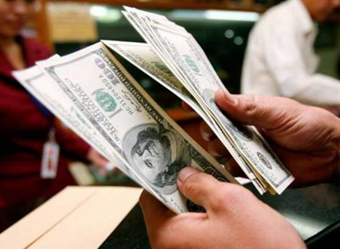Dollar prices inched higher versus a basket of major currencies on Tuesday, clinging above a three-year low set last week, but its outlook was clouded by concerns that the ballooning U.S. fiscal deficit could disrupt the economy.
The dollar’s index versus six major peers stood at 89.347, about 1.2 percent above Friday’s three-year low of 88.251.
The dollar has been weakening in recent months, with the positive impetus from rising U.S. interest rates offset by a barrage of bearish factors.
Initially, the view that other central banks will catch up with the Federal Reserve in tightening policy this year was cited as a reason for the dollar’s underperformance.
Then came comments from U.S. Treasury Secretary Steven Mnuchin, which stoked concerns the United States could pursue a weaker dollar policy as its trade deficit rose to highest level in almost a decade.
Mounting worries about the U.S. budget deficit, which is projected to balloon to more than $1 trillion in 2019 amid a government spending splurge and large corporate tax cuts, have also undermined the greenback.
“The dollar has been falling continuously, but with changing themes. At the moment, a projected increase in U.S. debt issuance, a reduction in Fed bond buying and bulging U.S. fiscal deficit are the main focus,” said Daisuke Uno, chief strategist at Sumitomo Mitsui Bank.
“That should mean U.S. long-term yields will remain high while the dollar will stay cheap,” he said.
Economists say U.S. President Donald Trump’s tax cuts and spending plans could backfire by overheating an already strong economy and causing an unwanted pick-up in inflation.
Against the yen, the dollar edged up 0.2 percent to 106.77 yen, having bounced back from a 15-month low of 105.545 set on Friday.
Stephen Innes, head of trading in Asia-Pacific for Oanda in Singapore, said there seemed to be some short-covering in the dollar in the wake of its recent fall.
“We’ve got a lot of Fed speakers…this week. I think that could be a reason why we’re seeing some of the short dollar positions pared back,” Innes said.
He added, however, that the dollar could come under pressure if this week’s U.S. government bond auctions were to show sluggish investor demand for U.S. debt.
The euro eased 0.2 percent to $1.2387, backing down from Friday’s three-year high of $1.2556.
Euro zone finance ministers on Monday chose Spanish Economy Minister Luis de Guindos to succeed European Central Bank Vice President Vitor Constancio in May.
The move is likely to boost the chances of German Bundesbank Governor Jens Weidmann becoming head of the ECB next year to succeed Mario Draghi in 2019, possibly giving the ECB’s policy a more hawkish tilt.
Expectations that the ECB will roll back its stimulus have been the major driving force behind the euro’s rally since last year.
Still, in the near term, investors may be cautious about buying the common currency given political uncertainty in the continent.
German Social Democrats (SPD) start voting in a postal ballot on Tuesday on whether the centre-left party should go ahead with the agreement its leaders clinched last week to renew their power-sharing alliance with the Chancellor Angela Merkel’s conservatives.
The results of the vote, which takes place as the SPD’s support has fallen behind that of the right-wing Alternative for Germany (AfD), is due on March 4.
Italy will also hold a general election on March 4, which is expected to result in a hung parliament.

